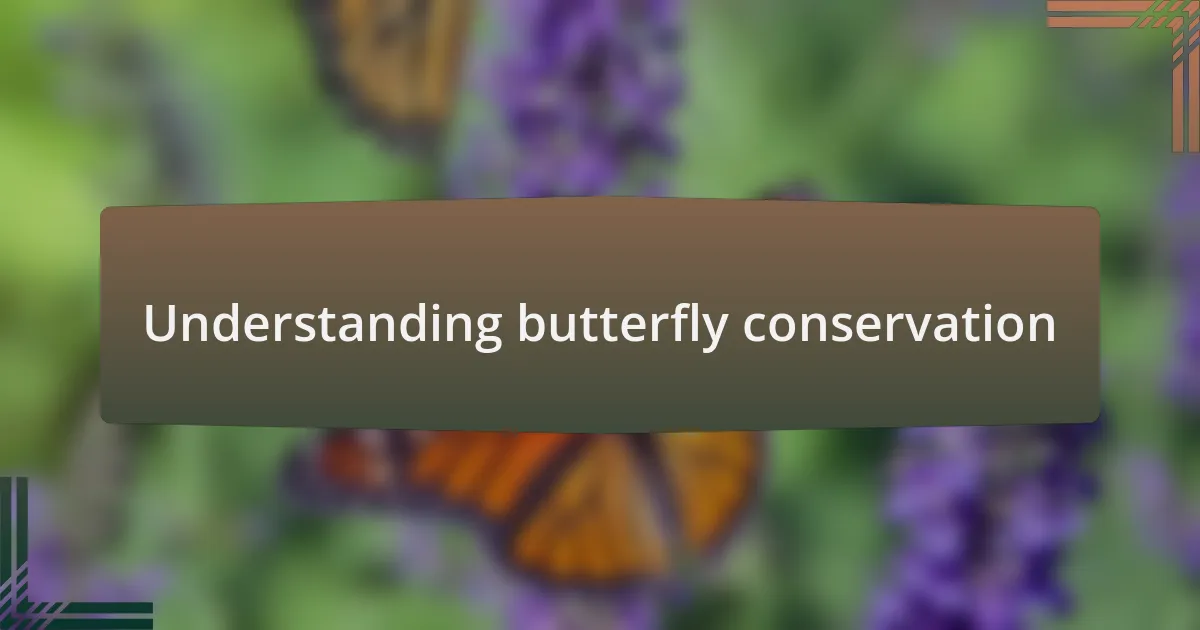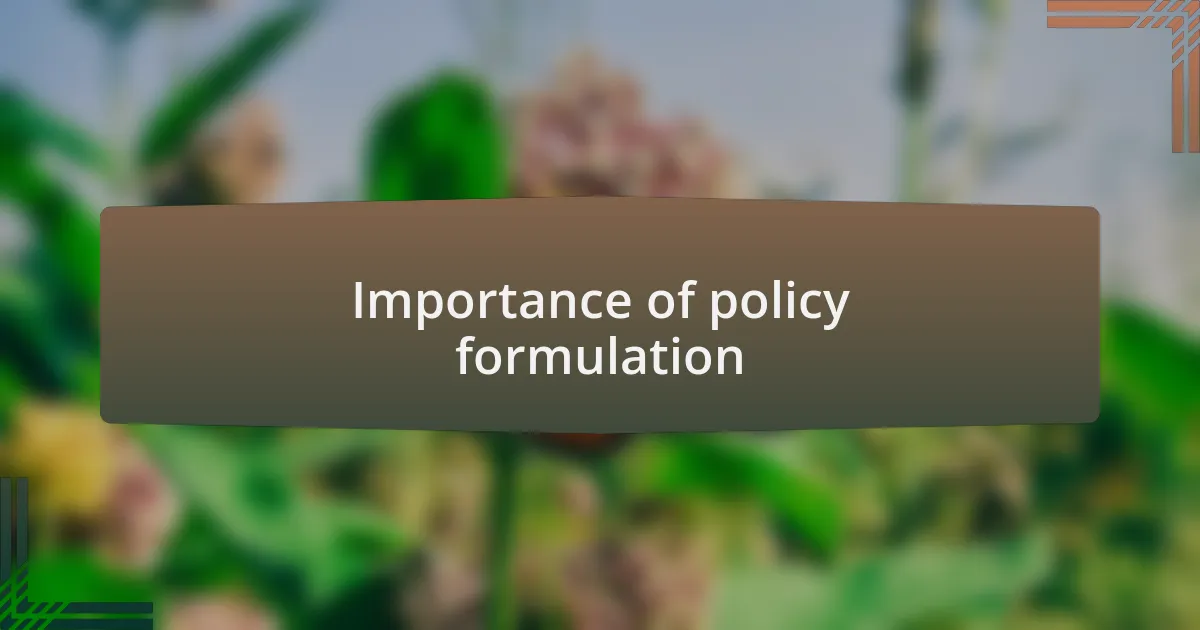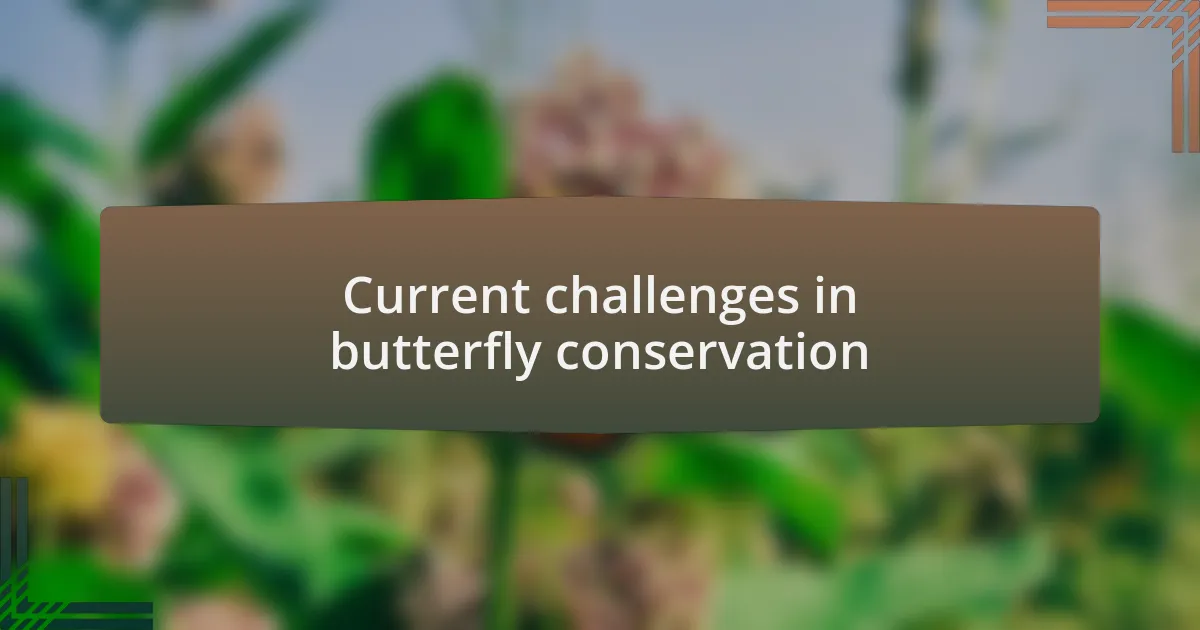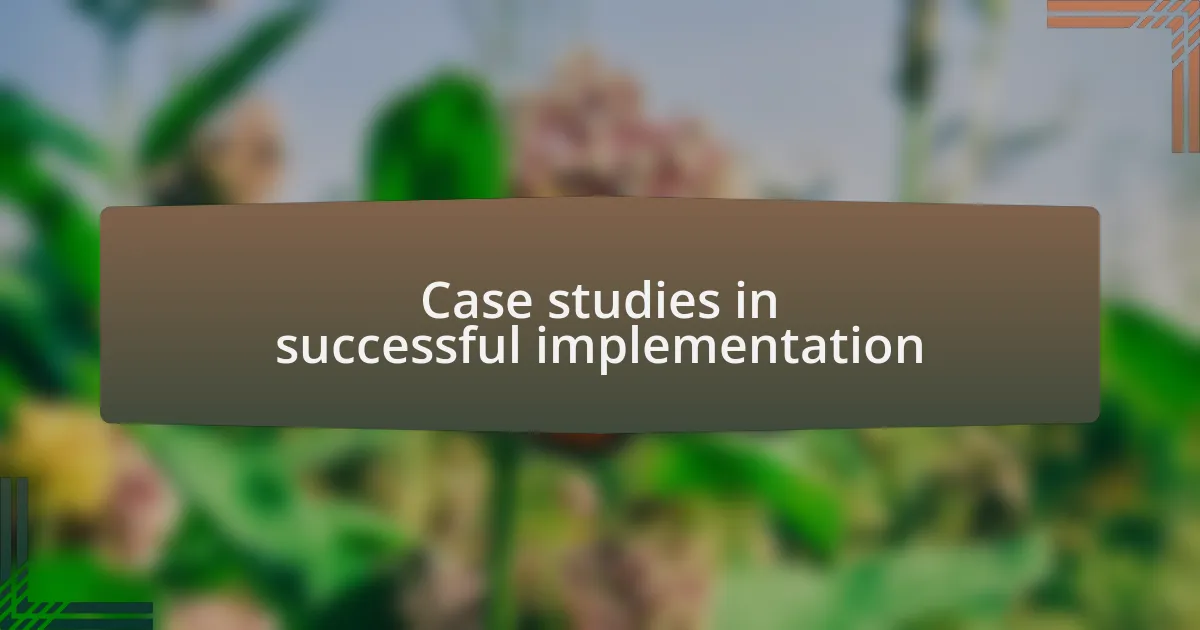Key takeaways:
- Butterfly conservation is essential for ecosystem health and biodiversity; it involves creating habitats that support their life cycles.
- Effective policy formulation is crucial for guiding conservation efforts, ensuring resource allocation, and fostering community involvement.
- Current challenges include habitat loss, climate change, and pesticide use, all of which threaten butterfly populations and require adaptive policy responses.
- Successful case studies highlight the importance of collaboration, community engagement, and integrating conservation with agriculture to enhance biodiversity.

Understanding butterfly conservation
Butterfly conservation is about more than just protecting these beautiful insects; it’s deeply intertwined with preserving the ecosystems they inhabit. I still remember the first time I witnessed a vibrant swarm of butterflies in a meadow, and the sheer joy and awe it evoked in me made me realize their vital role in our environment. Have you ever paused to think about how their existence can reflect the health of an entire ecosystem?
Engaging in butterfly conservation means understanding the delicate balance of nature. I often think about my own garden, where every flower I plant is a potential food source for a caterpillar or nectar for an adult butterfly. By creating habitats that cater to their life cycles, we can foster not only beauty but also biodiversity. Isn’t it fascinating how a simple change in our surroundings can make such a significant impact?
Moreover, many butterfly species are indicators of environmental change. I recall a recent field trip where we noted the absence of certain species that were once abundant. It sparked a discussion among us about climate change and habitat loss—issues we often take for granted. What does it tell us when we see fewer butterflies? It’s a pressing reminder that through communication and action, we can contribute to solutions that ensure these enchanting creatures continue to thrive.

Importance of policy formulation
Policy formulation is a critical process for guiding effective butterfly conservation efforts. I remember attending a local conservation meeting where we discussed the importance of policies in ensuring the preservation of butterfly habitats. The passion in the room was palpable, as everyone understood that without clear guidelines and supportive legislation, our efforts could easily fall short. How can we expect to make meaningful progress if we don’t establish a framework for action?
Having a structured policy not only outlines specific goals but also allocates resources effectively. During one project, we were able to implement a butterfly-friendly landscape initiative, thanks to city policies that prioritized biodiversity. It was inspiring to see how these guidelines transformed public parks, making them havens for butterflies and nurturing community awareness. Seeing families engage with these spaces and learn about their significance reminded me that policy truly paves the way for community involvement and education.
Moreover, effective policies enable collaboration among various stakeholders, from government agencies to local conservation groups. I’ve witnessed this firsthand when working alongside passionate volunteers and scientists united by a common vision. Together, we crafted a policy proposal that included actions not just for immediate results but for long-term sustainability. Isn’t it reassuring to think that when we join forces and strategize, we can create lasting change for something as delicate and vital as butterflies?

Current challenges in butterfly conservation
Current challenges in butterfly conservation are multifaceted and often overwhelming. Habitat loss remains a pressing concern, as urbanization and agricultural expansion continue to erode the natural spaces where butterflies thrive. I vividly recall walking through a once-flourishing meadow, now transformed into a housing development; it felt like a personal loss. How can we stand by and watch as the rich tapestry of life is unraveled one plot at a time?
Climate change adds another layer of complexity, disrupting the delicate balance that butterflies rely on. Increased temperatures and unpredictable weather patterns can alter migration routes and blooming seasons, affecting food availability. I remember feeling a mix of frustration and hope as I observed butterflies struggling to adapt; it highlighted the urgent need for adaptive policies that can respond to these shifting realities. What good is a policy if it doesn’t encompass the very essence of what butterflies need to survive?
Furthermore, pesticide use presents a significant barrier to butterfly populations, often decimating not just the targeted pests but also beneficial insects. In my community, I’ve seen the impact firsthand when neighbors used strong chemicals for lawn care, leading to a noticeable decline in local butterfly sightings. Isn’t it astonishing how choices made for convenience can ripple through ecosystems? We need to reconsider our approach and advocate for more sustainable practices to protect these fragile species.

Strategies for effective policy development
Effective policy development for butterfly conservation hinges on collaborative engagement among stakeholders. When I participated in a local conservation meeting, it struck me how diverse voices – including scientists, landowners, and community members – each brought unique perspectives. This dynamic dialogue enriches the policy-making process and ensures that solutions reflect the needs and realities on the ground.
Education is another cornerstone of sound policy strategies. I vividly recall organizing a workshop for schoolchildren to connect them with local butterflies. Watching their eyes light up as they learned about the species sparked a realization: informed communities are powerful advocates for conservation. Shouldn’t we strive to weave educational initiatives into policy frameworks so that future generations continue this crucial work?
Finally, monitoring and assessment must be integral to policy strategies. During a butterfly count I participated in, we documented not only species variety but also observed shifts in populations. These insights are invaluable; they can guide policy adjustments in real time. Isn’t it fascinating how data-driven decisions can align more closely with nature’s rhythms? Effective policies must be flexible, adapting as we learn more about the environments we strive to protect.

Case studies in successful implementation
One notable case study that comes to mind is the success of the Butterfly Conservation Trust in the UK with the “Back from the Brink” project. I remember a field visit where I witnessed the meticulous restoration efforts in action—habitat management, rewilding, and public engagement all rolled into one initiative. It’s astonishing how this project revived several butterfly species once thought to be lost, proving that targeted action can turn the tide for our fluttering friends.
Another powerful example is the local restoration project I volunteered for that focused on a specific endangered butterfly species in my region. The collaboration among local agencies, nonprofits, and volunteers was inspiring. We not only rebuilt habitats but also initiated community stewardship programs, which fostered a deep emotional connection between residents and butterflies. Can you imagine how empowering it felt to see the community rally around a shared goal? It solidified my belief that successful implementation is often rooted in grassroots enthusiasm.
I also think of a project in the United States where a coalition of researchers and farmers worked together to create pollinator-friendly landscapes. During a visit to one of the farms, I felt a sense of hope as I noticed how these practices enriched not just the butterfly populations but also the farm’s productivity. It’s a classic win-win scenario—doesn’t that remind us that integrating conservation with agriculture can yield benefits for both biodiversity and food security?

Future directions for butterfly policy
Future directions for butterfly policy should focus on strengthening cross-sector partnerships. I recall a recent discussion I had with a local policy advisor who emphasized the impact of combining conservation efforts with urban planning. If we can incorporate butterfly habitats into city designs, wouldn’t that enhance biodiversity in urban settings?
Additionally, implementing innovative funding mechanisms, such as eco-certification programs for businesses that support butterfly habitats, could be a game changer. I once saw a nearby café promote its commitment to local ecology by planting butterfly-friendly gardens. It sparked lively conversations among patrons about conservation. Isn’t it fascinating how aligning economic incentives with ecological goals can drive collective action?
Finally, the role of technology in future policies can’t be overlooked. I recently attended a webinar where experts discussed using data analytics to map butterfly populations more effectively. Imagine harnessing citizen science and mobile apps to involve communities in monitoring these beautiful insects! It’s inspiring to think about how technology can foster deeper connections between people and nature, ultimately guiding policy in creative and impactful ways.